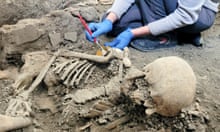Teresa Virtuoso is more than used to digging up tombs. But when the archaeologist found the skeleton of a man who died while trying to escape the catastrophic eruption of Mount Vesuvius in AD79, she couldn’t help but think about his final moments.
“At that moment, it wasn’t only about doing a job,” Virtuoso, who is coordinating excavations in part of Regio V, an entire quarter of the ancient Roman city of Pompeii that is yet to open to the public, told the Guardian.
“It made me think about the eruption and how afraid this man must have been as he ran. He was also found in an area that suffered most of Vesuvius’s damage; it would have been impossible to survive.”
He was the first victim to be found during excavations of Regio V, a 21.8-hectare (54-acre) site to the north of the archaeological park. The dig is the most intensive since the 1960s and symbolises a renaissance at the site, which earlier this decade was overcrowded and in parts crumbling.
Surprises unearthed so far this year include the remains of a horse; a home with an elaborate shrine; well-preserved mosaics and a bedroom fresco depicting an erotic scene from the Greek myth Leda and the Swan.
The discovery of the remains in May was even more startling as it appeared that the man had survived the initial phase of the eruption when the city was blanketed in volcanic ash and pumice. His torso was protruding from a large stone block but rather than being decapitated by it (the first appearance of his image online led some to call him history’s unluckiest man) archaeologist believe he was killed by the lethal gases of the eruption’s later stages.

The victim, believed to have been in his mid-30s, was also found with a small sack of 20 silver and two bronze coins, the equivalent of about €500 (£450) in today’s money.
Virtuouso said he probably took refuge in his home in the hours after the initial eruption, leaving only when he thought it was over. Experts established that he suffered from a physical defect that caused him to limp, thus hampering his escape from the doomed city.
In late October, the skeletons of two women and three children were discovered huddled together in the room of a villa in Regio V. A week earlier, the same villa revealed a charcoal inscription that suggested Vesuvius erupted in October AD79, and not in August of that year as previously thought.
Many of the homes uncovered had been damaged by a massive earthquake in Pompeii in AD62, but people continued to live in them, according to Francesco Muscolino, the archaeologist leading the excavations.
Various scrawls have also been found – including one believed to have been done by a child and spelling out “Sabinus”, the surname of an esteemed family of ancient Pompeii.

The city, which attracts almost 4 million visitors a year, has come a long way since 2013, when Unesco threatened to place it on its list of world heritage sites in peril unless Italian authorities improved its preservation.
The threat followed several incidents over the previous years, including the collapse of the House of Gladiators and a number of walls. Other shortcomings included a lack of qualified staff, structural damage and vandalism. Wide-ranging preservation works have taken place since then, while homes and alleys that were previously closed have been reopened, alleviating pressure on tourist congestion in popular areas.

Authorities have also discussed a new evacuation plan in case Mount Vesuvius erupts again.
For Massimo Osanna, the park’s superintendent, the biggest challenge is ensuring that the higher management standard is maintained.
“It doesn’t take much to slip backwards,” he said. “Previously there was a problem with supervision, but we need to be constantly monitoring.”
Part of that monitoring entails trying to educate people to respect the site.
“We had an issue with French schools organising treasure hunts, so children would be running around, touching frescoes and everything else,” added Osanna.
“Then you get those who climb on top of pillars to take selfies – it makes me so angry. The problem is stupidity, not understanding how fragile and unique Pompeii is.”

Tourists stealing artefacts is less of an issue nowadays after a museum displaying relics returned by repentant thieves was created. Park officials have received many letters expressing guilt, with some of the transgressions dating back to the 1980s.
The Pompeii ruins were discovered in the 16th century, with the first excavations beginning in 1748. One thousand five hundred of the estimated 2,000 victims have been found over the centuries.
Contemporary technology and DNA testing, as well as an interdisciplinary team that includes engineers, geologists, anthropologists and technical experts, helps to not only yield new finds but also shed more light on life in Pompeii before it was destroyed by Vesuvius.
With explorations at Regio V continuing into next year, there will no doubt be more to come. Osanna’s favourite discovery so far? “The man with the block on his head, it was astonishing, and the first time we found a victim that was so contextualised.”










